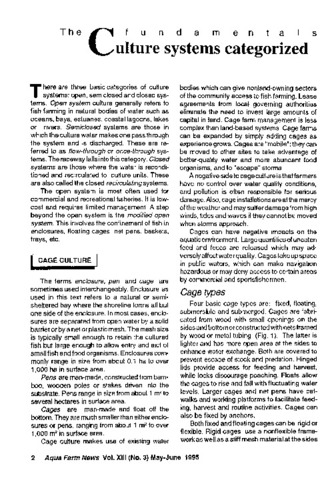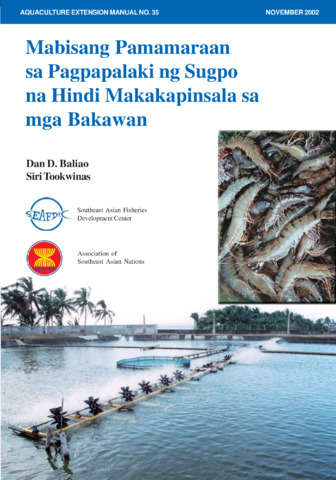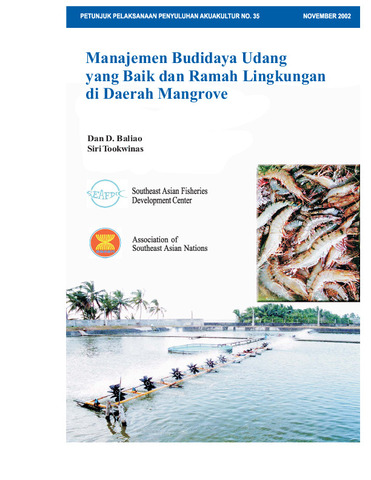A combined upflow and fluidized sand filter for recirculating systems
| dc.contributor.author | de los Reyes, Aurelio A., Jr. | |
| dc.date.accessioned | 2013-12-17T03:08:04Z | |
| dc.date.available | 2013-12-17T03:08:04Z | |
| dc.date.issued | 1999 | |
| dc.identifier.citation | De los Reyes, Jr., A. A. (1999). A combined upflow and fluidized sand filter for recirculating systems. Aquaculture Engineering, 14, 8-21. | en |
| dc.identifier.issn | 0117-8881 | |
| dc.identifier.uri | http://hdl.handle.net/10862/1845 | |
| dc.description | Paper contributed during the 13th Annual Meeting of the Society of Aquaculture Engineers of the Philippines held at the Central Philippine University, Iloilo City on 29 Novermber 1999. | en |
| dc.description.abstract | The process required and options for water treatment in recirculating systems have been clearly identified. The four most critical processes are: (1) solids removal, to take out fecal waste, uneaten feed, excess bacterial biomass, and other solids also reducing biochemical oxygen demand (BOD) in the process; (2) biological filtration or biofiltration, primarily nitrification to convert toxic ammonia and intermediate from nitrite to nitrate; (3) gas exchange, which includes aeration to ensure sufficient oxygen supply for fish and biofiltration, and degasification to stripe carbon dioxide; and what may be called (4) ion balance, primarily to maintain pH and alkalinity and prevent the buildup of nitrate, dissolved organic, and other substance. System with extended hydraulic retention times must generally have an alkalinity replenishment regime to compensate for the alkalinity-consuming nitrification process. Additional treatment processes include denitrification (nitrate removal, which helps to augment alkalinity), ozonation (to remove color, organics and BOD; also sterilizes), ultraviolet (UV) sterilization (for disease/pathogen control), and foam fractionation (to remove dissolved organics surfactants). Heaters and/or chillers may be provided for temperature control. It must be emphasized that while the processes and equipment are provided for specific purposes, a complex interrelationship exists in recirculating systems. Recirculating system components and sizing criteria vary widely, and are mainly provided to comply with specific production needs. A combined upflow and fluidized sand filter design that is applicable and easily adaptable to any system that may be recirculated is presented. Design and operational criteria are provided, as applied to a milkfish broodstock system. In general, for better management and control of water quality, to conserve water and energy and reduce wastewater, and to essentially provide for complete treatment of wastes and mitigate its impact on the environment, a high degree of water recirculation is recommended. | en |
| dc.language.iso | en | en |
| dc.publisher | Society of Aquaculture Engineers of the Philippines, Inc. | en |
| dc.subject | Philippines | en |
| dc.title | A combined upflow and fluidized sand filter for recirculating systems | en |
| dc.type | Article | en |
| dc.citation.volume | 14 | |
| dc.citation.spage | 8 | |
| dc.citation.epage | 21 | |
| dc.citation.journalTitle | Aquaculture Engineering | en |
| seafdecaqd.library.callnumber | VF SF 3454 | |
| seafdecaqd.databank.controlnumber | 1999-21 | |
| dc.subject.asfa | aquaculture engineering | en |
| dc.subject.asfa | aquaculture systems | en |
| dc.subject.asfa | recirculating aquaculture systems | en |
| dc.subject.asfa | sand | en |
| dc.subject.asfa | water filtration | en |
| dc.subject.asfa | water purification | en |
Files in this item
| Files | Size | Format | View |
|---|---|---|---|
|
There are no files associated with this item. |
|||
This item appears in the following Collection(s)
-
Journal Articles [1247]
These papers were contributed by Department staff to various national and international journals.



